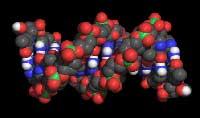What happened in the origin of life?
From a chemical point of view, life means that a molecule has the ability to self-copy. Today we would say that this molecule is the DNA, which contains all the information of the characteristics of the being. But when life arises, what was the first living molecule?
DNA needs proteins to be copied, so it could be thought that the first living molecule could be a protein. But proteins can't form another protein without the information contained in DNA, because they don't know what parts they should join for it. The problem seems trapped in an endless circle.

However, it must be taken into account that the steps between DNA and proteins are made by another molecule: RNA. This molecule is a copy of the information of the DNA and has the ability to join 'pieces', that is, to work the DNA and proteins. Therefore, for scientists, RNA was the first living molecule (when there were no proteins or DNA).
An experiment in the group led by U.S. biochemist David Lynn forces to review the question about the origin of life. In this experiment, a molecule similar to DNA has been autocopied without protein help. In addition, the union between the 'pieces' of the copy is a group of beloved well known by the chemicals. This group, that set of atoms of determined geometry, is similar to that which binds the pieces of conventional proteins.
We could not answer the chemical question about the origin of the first life. Perhaps there are now too many opportunities. In any case, an interesting debate can arise to try to choose the most appropriate response.
Buletina
Bidali zure helbide elektronikoa eta jaso asteroko buletina zure sarrera-ontzian











